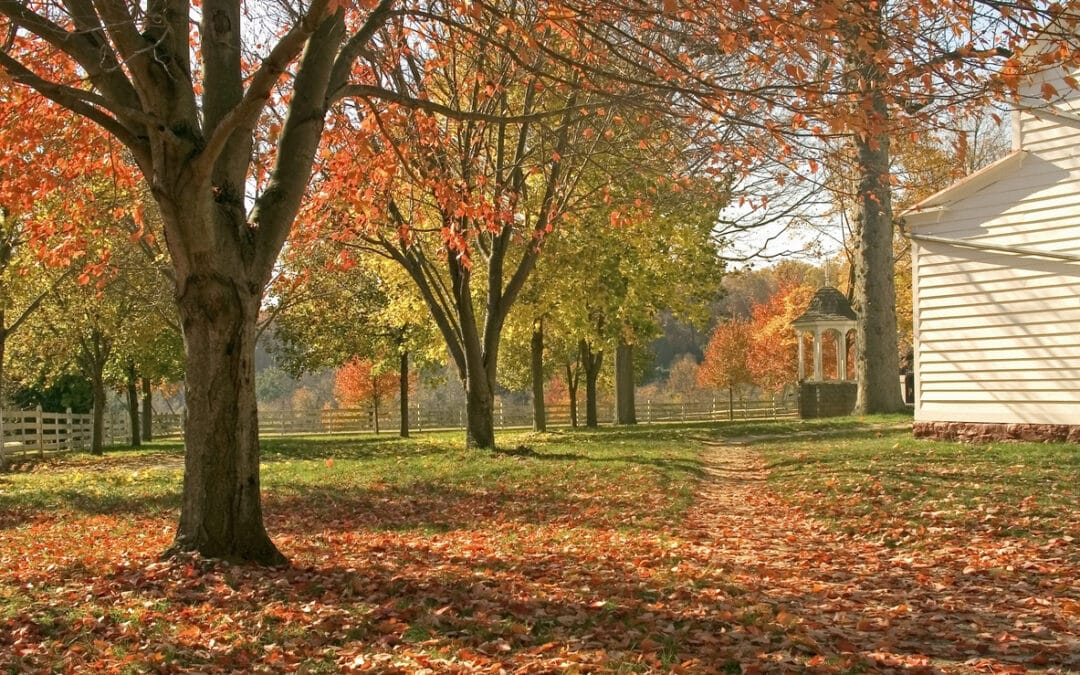Another New England summer has come and (almost) gone, and while the summer cookouts may be coming to a close, your yard still needs some attention! With summer slipping us by so quickly, now is the time to start thinking about fall yard prep.
Fall is a time of opportunity for your landscape: with its cooler temperatures, steady rainfall, and slowing growth, it’s the perfect season to reset and get your yard in shape for the months ahead.
A change in season calls for a new landscaping routine, and putting in the work now will lay the groundwork for a healthy, vibrant yard come spring. Consider this blog your guide for putting together an effective fall yard prep list!
Setting Your Lawn Up For Success
If your lawn fell a little flat this year, don’t give up hope. With the right growing techniques, your yard can bounce back and flourish next season.
Though it may seem early, fall is actually a prime time to set your yard up for success. Your grass is no longer under the stress of the scorching summer sun, while the soil is still warm enough to promote strong root growth. This is an ideal combination for effective rejuvenation.
Here are some of the key players in effective lawn prep that you’ll want to add to your fall lineup:
Weed Control
Put the work in now and enjoy a weed-free yard in the spring. Fall is when perennial or broadleaf weeds like dandelions, clover, and plantain are storing energy to survive the winter cold, but the right weed control techniques can suppress their growth.
1. Aim for Early Fall
Schedule herbicide application in September. This timing allows you to target weeds before they enter winter dormancy and provides enough time afterward to follow up with aeration, overseeding, and fertilization before the first freeze.
2. Ensure Compatibility With Your Grass
For New England property owners, you must use herbicides that are compatible with cool-season grasses. Using the wrong herbicide for your region can result in discoloration or interrupted growth cycles.
Core Aeration
Aeration is the process of loosening up the ground so that water and nutrients can penetrate the soil more deeply. It involves using a core aerator to create small, evenly spaced holes in the soil. Here are a few tips to keep you on track when aerating your lawn.
1. Aerate in Early to Mid-Fall
If you aerate too early, the summer heat can stress your lawn and defeat the point of the process. If you aerate too late, your grass won’t have enough time to recover and grow before it stops growing in the winter. Aim to aerate in early to mid-fall, while temperatures are lower but the grass is still actively growing.
2. Water Lawn Before Aeration
Water the grass about 24 to 48 hours before aeration. This will soften the soil enough for the aerator to penetrate effectively without it becoming soggy and causing the machine to tear up your lawn.
3. Mark Up Your Lawn
Mark where any obstructions are and steer clear of them. This includes all sprinkler heads, invisible fence wires, and shallow utility lines. If you happen to strike any of these with the aeroter, you risk permanent damage and expensive repairs.
To create effective and visible markings, we recommend using brightly colored flagging tape, flags, stakes, or lawn-safe spray paint.
Overseeding
Overseeding is designed to fill in stubborn dry patches in your lawn. We recommend seeding in the early fall, typically late August – October, for best results. Below you’ll find a few other considerations to keep in mind.
1. Type of Seed
For New England homes, it’s best to use a seed that is both adapted to cool climates and disease-resistant. That’s why cool-season grasses like Kentucky bluegrass, fine fescue, and perennial ryegrass tend to be popular throughout the region.
2. Watering
Maintain a moist lawn after seeding! Light watering 3 times per day for approx. 10-15 minutes per zone/section can ensure the seed has the opportunity to absorb water and begin germination. Aim for early morning or late evening to minimize evaporation.
Once the seed germinates—indicated by the appearance of new grass blades—you can modify your routine to deeper, less frequent watering.
Fertilization
Fall is an ideal time to fertilize your lawn. During this time of year, a new stage of growth, putting more of its energy toward root strengthening rather than blade growth.
During this phase of development, the grass is storing and absorbing more nourishment rather than using fertilizer nutrients for top growth.
Use a Slow-Release Fertilizer for Best Results
A slow-release fertilizer is exactly what it sounds like: a fertilizer that gradually releases nutrients over time. Slow-release fertilizers prevent nutrient overload and promote steady, sustained growth by delivering smaller amounts of nitrogen and other key elements over several weeks, rather than all at once. This is important as too much fertilizer at once can burn your lawn and sacrifice long-term root health.
PowerDown and Winterize Equipment
In addition to general lawn care, shutting down irrigation systems and winterizing equipment are essential steps in any successful fall landscape prep routine.
How to Shut Down Your Irrigation System
Don’t neglect your sprinkler or irrigation system. Just like spring startup, there’s a shutdown process that can prevent costly damage or costly repairs when followed carefully. Here’s an outline of what a proper irrigation system power-down entails.
1. Schedule Before the First Hard Freeze
Plan to winterize your irrigation system in late October or early November before temperatures consistently drop below freezing to avoid pipe bursts and equipment damage.
2. Perform a Thorough Blowout
Remove all water from pipes, valves, and sprinkler heads by blowing compressed air through the system to prevent freezing and cracking during winter.
3. Shut Off the Main Water Supply
Turn off water at the main valve and drain any backflow preventers or pressure regulators to protect components from freeze damage.
Landscape Equipment Winterization
Improper winterization of your equipment, such as your lawn mower, trimmer, or blower, can pose the risk of damage from freezing temperatures, corrosion, and mechanical failure. To properly prepare machinery for the brutal winter months, be sure to:
1. Drain Fuel
Gasoline left in engines can degrade and cause carburetor issues. Drain the fuel or add a stabilizer before storing equipment for winter.
2. Change Oil and Clean or Replace Air Filters
Fresh oil and clean filters help prevent engine wear and make starting easier next season.
3. Store Equipment in a Safe, Dry Area
Remove grass clippings, dirt, and debris to prevent rust and corrosion. Store tools and machines indoors or under a protective cover to shield them from moisture and freezing temperatures.
Need Help? G&H Landscaping Is Here for You
If you need assistance with fall landscaping and winterization, G&H Landscaping is here for you! We are your partner in creating and maintaining a healthy, beautiful yard—here for every seasonal transition.
To request fall cleanup services, get in touch via the button below.

